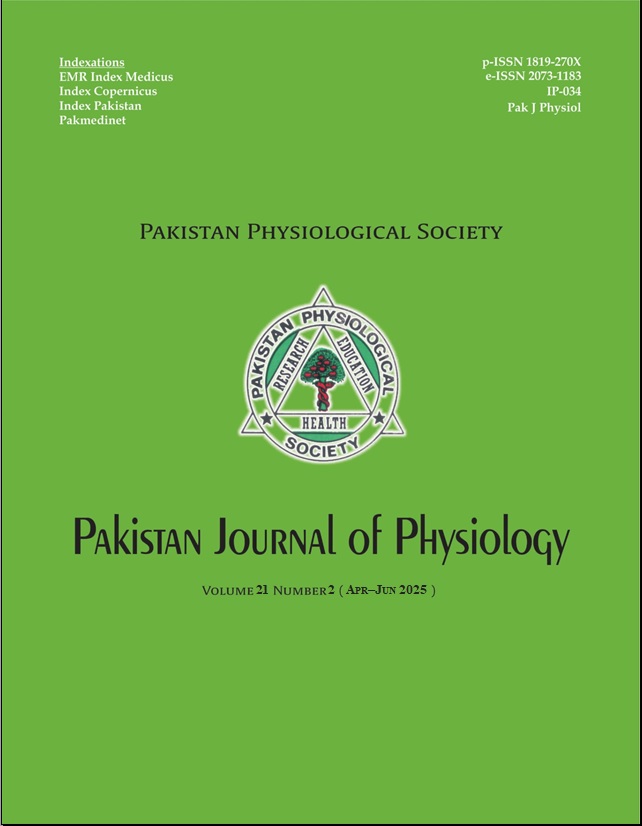SYMPHYSIS-FUNDAL HEIGHT MEASUREMENT IN ANTENATAL CARE AT LUMHS HOSPITAL, JAMSHORO: A CROSS-SECTIONAL STUDY
DOI:
https://doi.org/10.69656/pjp.v21i2.1692Keywords:
symphysis-fundal height, small-for-gestational-age, fetal growth monitoring, antenatal care, ultrasound, perinatal outcomes, resource-constrained settingsAbstract
Background: Routine symphysis-fundal height (SFH) measurement during pregnancy is a widely practiced method for estimating foetal size and gestational age in antenatal care. The objective of this study was to determine the SFH values at different gestational ages among pregnant women receiving antenatal care at LUMHS Hospital, Jamshoro and to assess the relationship between SFH and gestational age. Methods: This cross-sectional study was conducted at LUMHS Hospital, Jamshoro, involving 50 pregnant women aged 18?40 years. SFH measurements were initiated after 28 weeks of gestation and taken at regular intervals. Statistical analysis included mean and standard deviation of SFH values, and correlation analysis. Results: The mean age of the participants was 27.02±3.66 years, and mean gestational age was 32.62±2.83 weeks. Mean SFH during 28?38 weeks was 30.54±2.62 Cm and increased with advancing gestational age. There was a strong correlation between SFH and gestational age (r=0.998). Conclusion: Symphysial-fundal height measurement showed a strong correlation with gestational age, supporting its usefulness as a supportive tool in antenatal care. However, due to potential variability from clinical and foetal factors, SFH should complement—not replace—ultrasound assessment.
Pak J Physiol 2025;21(2):12-15, DOI: https://doi.org/10.69656/pjp.v21i2.1692
Downloads
References
Deeluea J, Sirichotiyakul S, Weerakiet S, Buntha R, Tawichasri C, Patumanond J. Fundal height growth curve for Thai women. ISRN Obstet Gynecol 2013;2013:463598.
World Health O. World health statistics. Geneva: World Health Organization; 2010.
Wardlaw TM. (Ed). Low Birthweight: Country, regional and global estimates. New York: UNICEF; 2004.
Bano R, Mushtaq A, Adhi M, Asim N, Afzal N. Incidence and outcome of small for gestational age foetuses: an experience from a secondary care hospital. J Pak Med Assoc 2013;63(11):1422–4.
Shamim A, Khan HO, Rana JS, Ahmed KA. Intrauterine growth restriction: a perspective for Pakistan. J Pak Med Assoc 1999;49(2):50–2.
Sherry B, Mei Z, Grummer-Strawn L, Dietz WH. Evaluation of and recommendations for growth references for very low birth weight (
Morken NH, Klungsoyr K, Skjaerven R. Perinatal mortality by gestational week and size at birth in singleton pregnancies at and beyond term: a nationwide population-based cohort study. BMC Pregnancy Childbirth 2014;14:172.
Sharma P, McKay K, Rosenkrantz TS, Hussain N. Comparisons of mortality and pre-discharge respiratory outcomes in small-for-gestational-age and appropriate-for-gestational-age premature infants. BMC Pediatr 2004;4:9.
Gatti JM, Kirsch AJ, Troyer WA, Perez-Brayfield MR, Smith EA, Scherz HC. Increased incidence of hypospadias in small-for-gestational age infants in a neonatal intensive-care unit. BJU Int 2001;87(6):548–50.
Jehan I, Zaidi S, Rizvi S, Mobeen N, McClure EM, Munoz B, et al. Dating gestational age by last menstrual period, symphysis-fundal height, and ultrasound in urban Pakistan. Int J Gynaecol Obstet 2010;110(3):231–4.
Salihoglu O, Karatekin G, Uslu S, Can E, Baksu B, Nuhoglu A. New intrauterine growth percentiles: a hospital-based study in Istanbul, Turkey. J Pak Med Assoc 2012;62(10):1070–4.
Gardosi J. New definition of small for gestational age based on fetal growth potential. Horm Res 2006;65 (Suppl 3):15–8.
Buchmann E. Routine Symphysis-fundal height measurement during pregnancy: RHL commentary. Geneva: WHO; 2003. Available from: http://apps.who.int/rhl/pregnancy_childbirth/ antenatal_care/general/ebguide/en [Accessed: 13 Sep 2024]
Ego A, Monier I, Vilotitch A, Kayem G, Vayssiere C, Verspyck E, et al. Serial plotting of symphysis-fundal height and estimated fetal weight to improve the antenatal detection of infants small for gestational age: A cluster randomised trial. BJOG 2023;130(7):729–39.
Dias T, Abeykoon S, Kumarasiri S, Gunawardena C, Pragasan G, Padeniya T, Pathmeswaran A. Symphysis-pubis fundal height charts to assess fetal size in women with a normal body mass index. Ceylon Med J 2016;61(3):106–112. https://doi.org/10.4038/ cmj.v61i3.8345. [Accessed: 13 Sep 2024]
Thorsell M, Kaijser M, Almstrom H, Andolf E. Expected day of delivery from ultrasound dating versus last menstrual period–obstetric outcome when dates mismatch. BJOG 2008;115:585–9.
Bussmann H, Koen E, Arhin-Tenkorang D, Munyadzwe G, Troeger J. Feasibility of an ultrasound service on district health care level in Botswana. Trop Med Int Health 2001;6:1023–31.
Andersen HF, Johnson TR Jr, Barclay ML, Flora D Jr. Gestational age assessment. I. Analysis of individual clinical observations. Am J Obstet Gynecol 1981;139:173–7.
Freire DM, Cecatti JG, Paiva CS. Symphysis-fundal height curve in the diagnosis of fetal growth deviations. Rev Saude Publica 2010;44(6):1031–8.
Sparks TN, Cheng YW, McLaughlin B, Esakoff TF, Caughey AB. Fundal height: a useful screening tool for fetal growth? J Matern Fetal Neonat Med 2011:24(5):708–12.
Morse K, Williams A, Gardosi J. Fetal growth screening by fundal height measurement. Best Pract Res Clin Obstet Gynaecol 2009;23:809–18.
Parveen U, Brohi ZP, Sadaf A. Identification of factors affecting the symphysio-fundal height and prediction of low birth weight (LBW) during antenatal period. Pak J Med Health Sci 2021;15(12):3678–80.
National Institute for Health and Clinical Excellence (NICE). Antenatal care: NICE Clinical Guideline 62. NICE Clinical Guidelines. 2010. Available from: http://www.nice.org.uk/ nicemedia/liv1194/7/40115/40115.pdf. [Accessed: 13 Sep 2024]
Linasmita V, Sugkraroek P. Normal uterine growth curve by measurement of symphysial-fundal height in pregnant women seen at Ramathibodi Hospital. J Med Assoc Thai 1984;67(Suppl 2):22–6.
Downloads
Published
How to Cite
Issue
Section
License
Copyright (c) 2025 Saba Kalhoro, Sara Laghari, Afshan Memon, Maliha Fatima, Neeta Maheshwary, Muhammad Athar Khan

This work is licensed under a Creative Commons Attribution-NoDerivatives 4.0 International License.
The author(s) retain the copyrights and allow their publication in Pakistan Journal of Physiology, Pak J Physiol, PJP to be FREE for research and academic purposes. It can be downloaded and stored, printed, presented, projected, cited and quoted with full reference of, and acknowledgement to the author(s) and the PJP. The contents are published with an international CC-BY-ND-4.0 License.











